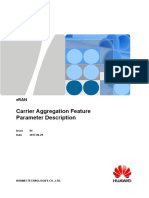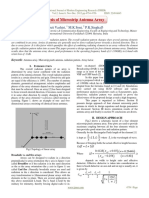Antena Fractal PDF
Antena Fractal PDF
Uploaded by
Kathy JácomeCopyright:
Available Formats
Antena Fractal PDF
Antena Fractal PDF
Uploaded by
Kathy JácomeOriginal Title
Copyright
Available Formats
Share this document
Did you find this document useful?
Is this content inappropriate?
Copyright:
Available Formats
Antena Fractal PDF
Antena Fractal PDF
Uploaded by
Kathy JácomeCopyright:
Available Formats
1
DESIGN AND SIMULATION OF MICROSTRIP
ARRAY ANTENNA FOR 2.4 Ghz.
Katherine Jácome, Angel Toapanta, Jahit Buenaño
kathyjc@gmail.com,santiago@hotmail.com, jahitbm@gmail.com
Escuela Superior Politécnica de Chimborazo
Riobamba, Ecuador
Abstract—In this paper we present the design of a Microstrip has more control of the feed of each element (amplitude and
Array Antenna, where return losses below than 10 dB at phase) and it is ideal for scanning phased arrays, multibeam
resonance frequency. Operating frequency of the antenna is 2.4 arrays, or shaped-beam arrays. The radiated field formula is
GHz, so is suitable for L-band and S-band application. In order
to design and simulate we used the Ansoft Designer software, given in Equation is same for this array and array factor as
for the implementation and testing we used glass epoxy Fr-4 given in:
substrate. This antenna offers a bandwidth of 1.25 percent
FA = (sin2 (N π)(dx /λ)sinΘa )/N 2 sin2 (π(dx /λ)sinΘa )
Keywords: Arrays, Radiation pattern, Array factor
(sin2 (M π)(dy /λ)sinΘe )/M 2 sin2 (π(dy /λ)sinΘe )
I. INTRODUCTION Combining the element radiation pattern and array factor
I crowave equipments require low profile and light- we get the normalized power radiation pattern. The substrate
M weight to assure reliability, an antenna with these
characteristics is essentially required and a microstrip antenna
permittivity of the antenna is Er=4.4, height is 1.58 mm and
resonance frequency of the antenna is 2.4 GHz, this can be
satisfies such requirement. [1] used in band WLAN system.
The key features of a microstrip antenna are relative ease of
construction, light weight, low cost and either conformability
to the mounting surface or, at least, an extremely thin III. DESIGN
protrusion from the surface. Microstrip arrays are limited in
that they tend to radiate efficiently only over a narrow band In Fig 1. we observed the design of the array antenna with
of frequencies and they can not operate at the high power adaptation λ/4yinAnsof Designersof tware
levels of waveguide, coaxial line, or even stripline [2].
In various communications and radar systems microstrip
antenna is greatly desired. Microstrip antennas are very
versatile and are used, among other things, to synthesize
a required pattern that cannot be achieved with a single
element.[3].
In addition, they are used to scan the beam of an antenna
system, increase the directivity, and perform various other
functions which would be difficult with any one single
element.[4].
The elements can be fed by a single line or by multiple lines
in a feed network arrangement. The first is referred to as
a series-feed network while the second is referred to as a
corporate-feed network [5].
Fig. 1: Simulation of the antenna array
II. MICROSTRIP CORPORATED-FEED ARRAY
ANTENNA DIMENSION MICROSTRIP ARRAY ANTENNA
The corporate-feed network is used to provide power splits
of 2n (i.e., n = 2, 4, 8, 16, 32, etc.). This is accomplished
by using wavelength impedance transformers. Corporate-fed The TABLE I shows the dimensions for the slot and
arrays are general and versatile. With this method the designer for each of the segments antenna.
2
l 28.26 mm
l1 15 mm
l2 16 mm
l3 13 mm
l4 15 mm
l5 13 mm
l6 16 mm
d 56 mm
d1 53 mm
d2 160 mm
TABLE I: Dimensions of the antenna array
IV. SIMULATION
In the Fig 2 As a result the necessary frequencies were
obtained with the reformed antenna measurements. The mea-
surements and the frequency of work are more real. We
observe it in the first instance fc = 2.4 GHz this is the main
frequency, with a bandwidth of 1.25 percent. The application Fig. 4: Radiation pattern 3D
of this antenna for the frequency of 2.4 GHz focuses on
applications in suitable L-band and S-band and gain -30 dB.
In the Fig 5. We note that the coupling of the antenna with
the 50-ohm power line is acceptable as the reactance value is
close to zero and the resistance value is close to 50-ohms
Fig. 2: Gain of the antenna
In the Fig 3. it is shown the radiation pattern for the CMPA Fig. 5: Impedance port
both in 2D , in which it can be seen that the antenna is
omnidirectional.In the design program, the radiation pattern
in HPBW is 10 degrees and FNBW is plotted in 20 degrees.
Fig. 3: Radiation pattern 2D Fig. 6: Impedance Port Table
3
V. CONCLUSIONS
• The His results show that the antenna is operating at a
frequency of 2.4 Ghz with return losses of -30 dBs, which
indicates the correct operation of the same. We also have
a percentage of bandwidth of 1.25 percent.
R EFERENCES
[1] Mailloux, R. J., J. F. Mcllvenna, and N. P. Kernweis, Microstrip array
technology IEEE Trans. Antennas Propagat, Vol. 29, No. 1, 2527,
January 1981.
[2] Balanis, C. A Antenna Engineering,2nd Edition, Willey. .
[3] Milligan, T. A Design of modified geometry Sierpinski carpet fracta-
lantenna array for wireless communicationModern Antenna Design, 2nd
EditionIEEE Antennas and Wireless Propagation Letters , pp. 435-439,
2013. IEEE Press, John Wiley Sons inc,Publication.
[4] Skolnik, M. I.Introduction to RADAR System, 3rd Edition, McGraw Hill
Higher Education,
[5] Garg, R., P. Bhartia, I. Bahl, and A. IttipiboonAntenna Design Hand-
book, Artech House, INC., 2001.
You might also like
- Carrier AggregationDocument994 pagesCarrier Aggregationaman_sn50% (4)
- Hw1 10 SolutionsDocument3 pagesHw1 10 SolutionsYi ZhangNo ratings yet
- 2.45GHz Patch AntennaDocument7 pages2.45GHz Patch AntennawearoleNo ratings yet
- Log-Periodic Patch Antenna With Tunable Frequency: M. F. Ismail, M. K. A. Rahim, F. Zubir, O. AyopDocument5 pagesLog-Periodic Patch Antenna With Tunable Frequency: M. F. Ismail, M. K. A. Rahim, F. Zubir, O. AyopZayar HeinNo ratings yet
- A Design of Rectangular Patch Antenna With Fractal Slots For Multiband ApplicationsDocument4 pagesA Design of Rectangular Patch Antenna With Fractal Slots For Multiband ApplicationsmarceloNo ratings yet
- Dual Band Microstrip Wearable Antenna DesignDocument4 pagesDual Band Microstrip Wearable Antenna Designekrem akarNo ratings yet
- 8 PDFDocument4 pages8 PDFsastry garuNo ratings yet
- Design and Performance Analysis of Microstrip Array AntennaDocument6 pagesDesign and Performance Analysis of Microstrip Array Antennasonchoy17No ratings yet
- Butterfly Shaped Printed Monopole Antenna For Ultra Wide Band ApplicationsDocument7 pagesButterfly Shaped Printed Monopole Antenna For Ultra Wide Band ApplicationsKumarNo ratings yet
- Designing of Microstrip Patch Antenna For Bluetooth ApplicationsDocument4 pagesDesigning of Microstrip Patch Antenna For Bluetooth Applicationsmahjoubi RabieNo ratings yet
- Designing of A 2x2 E-Shaped Microstrip Patch Grid Antenna: 2. Design ProcedureDocument5 pagesDesigning of A 2x2 E-Shaped Microstrip Patch Grid Antenna: 2. Design Procedureओम सिहNo ratings yet
- Project ReportDocument6 pagesProject ReportLeo7 ProdNo ratings yet
- A Conformal - Microstrip - Patch - Antenna - On - Cylinder - Back-to-Back - 2Document6 pagesA Conformal - Microstrip - Patch - Antenna - On - Cylinder - Back-to-Back - 2bisu sahooNo ratings yet
- Grilo Et Al-2012-Microwave and Optical Technology LettersDocument4 pagesGrilo Et Al-2012-Microwave and Optical Technology LettersAml LimaNo ratings yet
- Analysis of 2x2 Microstrip Patch Array Antenna Using Various Feeding Techniques.Document6 pagesAnalysis of 2x2 Microstrip Patch Array Antenna Using Various Feeding Techniques.amey salunkeNo ratings yet
- Gcat 2019-20Document4 pagesGcat 2019-20pNo ratings yet
- 10 Ragib KhanDocument3 pages10 Ragib KhanPRIETHAMJE VITHYANo ratings yet
- 23-4053 Roshni.S.Babu PDFDocument5 pages23-4053 Roshni.S.Babu PDFMonaElabbassiNo ratings yet
- Ext 20185Document5 pagesExt 20185Bouhafs AbdelkaderNo ratings yet
- Corrected ConferenceDocument5 pagesCorrected ConferenceSarath KumarNo ratings yet
- JETIR1905Y65Document4 pagesJETIR1905Y65sreelakshmi.ece eceNo ratings yet
- Wideband Circularly Polarized Dielectric Resonator Antenna Coupled With Meandered-Line Inductor For ISM/WLAN ApplicationsDocument7 pagesWideband Circularly Polarized Dielectric Resonator Antenna Coupled With Meandered-Line Inductor For ISM/WLAN Applicationschandravilash.raiNo ratings yet
- Design of Aperture Coupled Micro-Strip Patch Antenna For Wireless Communication Applications at 5.8GhzDocument4 pagesDesign of Aperture Coupled Micro-Strip Patch Antenna For Wireless Communication Applications at 5.8GhzShesha PrasadNo ratings yet
- A Compact Dual Band Planar Branched Monopole Antenna For DCS2.4-GHz WLAN ApplicationsDocument3 pagesA Compact Dual Band Planar Branched Monopole Antenna For DCS2.4-GHz WLAN ApplicationspsgshyamNo ratings yet
- Bandwidth Enhancement of Probe Fed Microstrip Patch Antenna: Parminder Singh Anjali Chandel Divya NainaDocument4 pagesBandwidth Enhancement of Probe Fed Microstrip Patch Antenna: Parminder Singh Anjali Chandel Divya Nainayusuf shabanNo ratings yet
- Mircostrip Patch Antenna With E Shaped Structure For S-Band ApplicationsDocument5 pagesMircostrip Patch Antenna With E Shaped Structure For S-Band ApplicationsijsretNo ratings yet
- Small Microstrip Patch AntennaDocument2 pagesSmall Microstrip Patch Antenna正气歌No ratings yet
- MERR Inspired CPW Fed SSGF Antenna For Multiband Operations: Nirmala Jayarenjini and Cheruvathoor UnniDocument15 pagesMERR Inspired CPW Fed SSGF Antenna For Multiband Operations: Nirmala Jayarenjini and Cheruvathoor UnnibabuNo ratings yet
- Analysis of Microstrip Antenna Array: Shruti Vashist, M.K Soni, P.K.Singhal3Document3 pagesAnalysis of Microstrip Antenna Array: Shruti Vashist, M.K Soni, P.K.Singhal3Kishor.ece. anuNo ratings yet
- 8.design of An S-Band Rectangular Microstrip Patch AntennaDocument8 pages8.design of An S-Band Rectangular Microstrip Patch Antennasrinivas08427No ratings yet
- Design of Circularly Polarized Array Antenna For 5.8GHz Microwave Wireless Power Transmission enDocument13 pagesDesign of Circularly Polarized Array Antenna For 5.8GHz Microwave Wireless Power Transmission enshiendykeinNo ratings yet
- Development of Cross Cut Shape Rectangular Microstrip Patch Antenna & Compare With Normal Microstrip Patch AntennaDocument5 pagesDevelopment of Cross Cut Shape Rectangular Microstrip Patch Antenna & Compare With Normal Microstrip Patch AntennatheijesNo ratings yet
- Microstrip Antennas System Considering A Triangular Double Stub Patch Antenna and An Array Patch AntennaDocument7 pagesMicrostrip Antennas System Considering A Triangular Double Stub Patch Antenna and An Array Patch AntennaAlex YautibugNo ratings yet
- A High Gain Six Band Frequency Independent Dual CP Planar Log Periodic Antenna For Ambient RF Energy HarvestingDocument5 pagesA High Gain Six Band Frequency Independent Dual CP Planar Log Periodic Antenna For Ambient RF Energy HarvestingAbraham KurienNo ratings yet
- Metodos de DiseñoDocument4 pagesMetodos de DiseñoAlex Jarrin RNo ratings yet
- Design of Microstrip Patch Antenna With Specific Structure IDocument13 pagesDesign of Microstrip Patch Antenna With Specific Structure Ihim4alllNo ratings yet
- Design and Development of Microstrip Patch Antenna at 2.4 GHZ For Wireless ApplicationsDocument5 pagesDesign and Development of Microstrip Patch Antenna at 2.4 GHZ For Wireless ApplicationsSpagnuolo Domenico PioNo ratings yet
- Design of A Stacked Two Layer Circular Fractal Microstrip Antenna For X-Band ApplicationDocument5 pagesDesign of A Stacked Two Layer Circular Fractal Microstrip Antenna For X-Band ApplicationRamya RNo ratings yet
- Experimental Investigation On The Design and Optimization of A W-Lan Band Rectangular Micro Strip Patch Antenna With Transmision Line FeedingDocument4 pagesExperimental Investigation On The Design and Optimization of A W-Lan Band Rectangular Micro Strip Patch Antenna With Transmision Line Feedingmagy1989No ratings yet
- Design and Simulation of Rectangular Microstrip Patch Antenna For C-Band ApplicationsDocument4 pagesDesign and Simulation of Rectangular Microstrip Patch Antenna For C-Band ApplicationsTanko SuleNo ratings yet
- 2x2 Patch Array AntennaDocument4 pages2x2 Patch Array AntennaDeshdeepGupta100% (2)
- Comparison and Performance Evaluation On MicrostriDocument5 pagesComparison and Performance Evaluation On Microstrichairianis36No ratings yet
- Microstrip Patch Antenna Array at 3.8 GHZ For WiMax and UAV ApplicationssDocument4 pagesMicrostrip Patch Antenna Array at 3.8 GHZ For WiMax and UAV ApplicationssHassan SajjadNo ratings yet
- Group 27Document5 pagesGroup 27jagacon689No ratings yet
- Planar Rectangular Microstrip Antenna For Dualband OperationDocument4 pagesPlanar Rectangular Microstrip Antenna For Dualband OperationLive To LoveNo ratings yet
- Paper NewDocument8 pagesPaper NewDrubo NilNo ratings yet
- Reconfigurable Stacked Microstrip Patch Antenna For Multi-Band ApplicationDocument5 pagesReconfigurable Stacked Microstrip Patch Antenna For Multi-Band ApplicationAmador Garcia IIINo ratings yet
- Analysis of A Rectangular Monopole Patch AntennaDocument4 pagesAnalysis of A Rectangular Monopole Patch AntennaГордан ЃоргоскиNo ratings yet
- Final Report ETE 300 PDFDocument5 pagesFinal Report ETE 300 PDFETE 18No ratings yet
- Chater 2018Document5 pagesChater 2018Jocilene Dantas Torres NascimentoNo ratings yet
- AntenDocument6 pagesAntenvõ hoài namNo ratings yet
- Design of A Compact Wide Band Microstrip Antenna With Very Low VSWR For Wimax ApplicationsDocument6 pagesDesign of A Compact Wide Band Microstrip Antenna With Very Low VSWR For Wimax ApplicationsaparnaNo ratings yet
- An Omnidirectional Printed Collinear Microstrip Antenna ArrayDocument6 pagesAn Omnidirectional Printed Collinear Microstrip Antenna ArraysaeedfsaeedNo ratings yet
- Review Paper For Circular Microstrip Patch Antenna: ISSN 2249-6343Document4 pagesReview Paper For Circular Microstrip Patch Antenna: ISSN 2249-6343Charan Macharla'sNo ratings yet
- Mezaal 2016Document4 pagesMezaal 2016Ahlam BOUANINo ratings yet
- A Simple Frequency Reconfigurable Microstrip Patch Antenna For Wireless CommunicationDocument5 pagesA Simple Frequency Reconfigurable Microstrip Patch Antenna For Wireless CommunicationMes TAREKNo ratings yet
- IJME Vol 4 Iss 4 Paper 4 687 692 PDFDocument6 pagesIJME Vol 4 Iss 4 Paper 4 687 692 PDFPavan TNo ratings yet
- New High-Gain Differential-Fed Dual-Polarized Filtering Microstrip Antenna For 5G ApplicationsDocument5 pagesNew High-Gain Differential-Fed Dual-Polarized Filtering Microstrip Antenna For 5G ApplicationsTétouan MoumenNo ratings yet
- Design and Analysis of Triple Band Rectangular Microstrip Patch Antenna ArrayDocument5 pagesDesign and Analysis of Triple Band Rectangular Microstrip Patch Antenna ArrayMandeep Singh WaliaNo ratings yet
- Gain Enhancement AntennaDocument7 pagesGain Enhancement AntennaMonaElabbassiNo ratings yet
- Circular Polarization Wideband E-Shaped Patch Antenna For Wireless ApplicationsDocument3 pagesCircular Polarization Wideband E-Shaped Patch Antenna For Wireless ApplicationserpublicationNo ratings yet
- Radio Frequency Identification and Sensors: From RFID to Chipless RFIDFrom EverandRadio Frequency Identification and Sensors: From RFID to Chipless RFIDNo ratings yet
- Hicom Eng PVT ProfileDocument29 pagesHicom Eng PVT ProfileM. Sohail AnwarNo ratings yet
- Popcorn Hour C-200 UserGuideDocument121 pagesPopcorn Hour C-200 UserGuidewarathornNo ratings yet
- Call Block GrameenphoneDocument2 pagesCall Block GrameenphoneZahangir Alam100% (3)
- AQU4518R7: Antenna SpecificationsDocument3 pagesAQU4518R7: Antenna SpecificationsAnnBlissNo ratings yet
- Multiple Choice Questions For Digital Signal ProcessingDocument128 pagesMultiple Choice Questions For Digital Signal Processingpriya100% (2)
- Isaac Laryea Presentation ItuDocument26 pagesIsaac Laryea Presentation ItuChetan BhatNo ratings yet
- B Multicast CG Asr9k 71xDocument342 pagesB Multicast CG Asr9k 71xjohnNo ratings yet
- Simple InstructionsDocument12 pagesSimple Instructionsvalentin bajinaruNo ratings yet
- CRM & Indian Telecom SectorDocument2 pagesCRM & Indian Telecom SectornehagypsyNo ratings yet
- CN Lab-8Document10 pagesCN Lab-8JAWERIA ASLAMNo ratings yet
- Huawei Material ListDocument1 pageHuawei Material ListBravo manNo ratings yet
- LTE OptimizationDocument18 pagesLTE OptimizationhammadleoNo ratings yet
- Form Request Apps ViSA - v1.6 - Putra - Adi - SuswadiDocument4 pagesForm Request Apps ViSA - v1.6 - Putra - Adi - SuswadiandiNo ratings yet
- It Works REPW300 Range ExtenderDocument62 pagesIt Works REPW300 Range Extenderpestana58No ratings yet
- c800 Full Duplex Intercom System ManualDocument9 pagesc800 Full Duplex Intercom System ManualGod engineerNo ratings yet
- 3GPP TS 23.401 PDFDocument258 pages3GPP TS 23.401 PDFtarish_goyal100% (2)
- Bgan Overview Brochure enDocument8 pagesBgan Overview Brochure enSiddharth BawaNo ratings yet
- Huawei AOC4518R8v06Document7 pagesHuawei AOC4518R8v06RNNicoll100% (1)
- Airborne Internet1Document10 pagesAirborne Internet1Manpreet SinghNo ratings yet
- Pmod RF2Document3 pagesPmod RF2Juan BuenoNo ratings yet
- Pasa LoadDocument4 pagesPasa LoadDwardenHelixNo ratings yet
- Nutanix Certified Professional (NCP) 5.5-Q & ADocument13 pagesNutanix Certified Professional (NCP) 5.5-Q & ATejas ThoratNo ratings yet
- Large Led MatrixDocument2 pagesLarge Led MatrixJPT YTNo ratings yet
- Репитер SHIYAM PDFDocument62 pagesРепитер SHIYAM PDFmypanacea0% (1)
- Cs PSPC XL Onboard 200m 185m Single Band Mobile Radio Spec SheetDocument4 pagesCs PSPC XL Onboard 200m 185m Single Band Mobile Radio Spec SheetLia LiawatiNo ratings yet
- PCM6220 ConfGuideDocument126 pagesPCM6220 ConfGuidekwalldioNo ratings yet
- Pricing Strategies and Competition in The Mobile Broadband MarketDocument28 pagesPricing Strategies and Competition in The Mobile Broadband MarketAfaq KhanNo ratings yet
- CCNA4 SyllabusDocument6 pagesCCNA4 SyllabusChristian FloresNo ratings yet

























































































